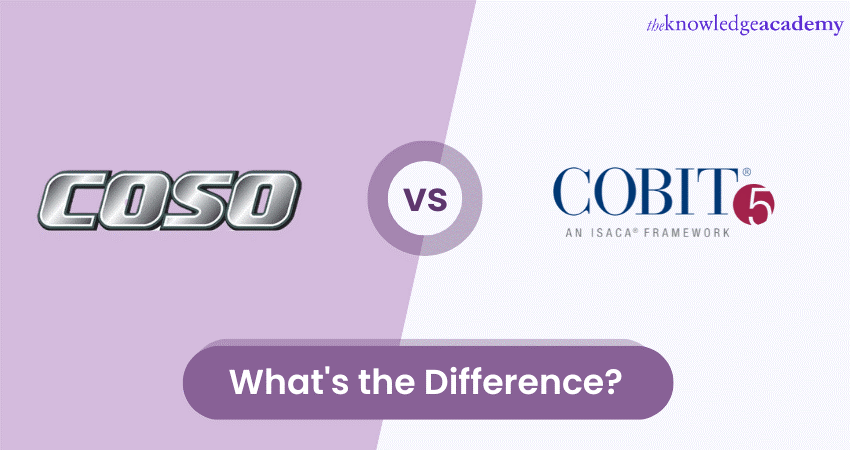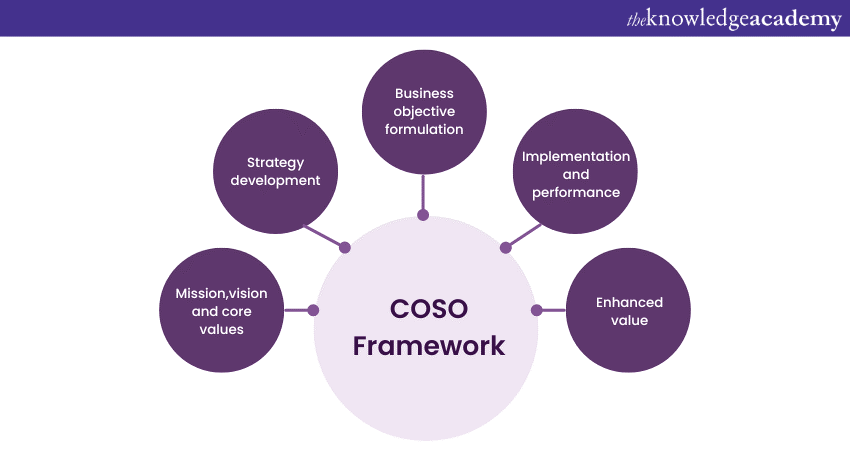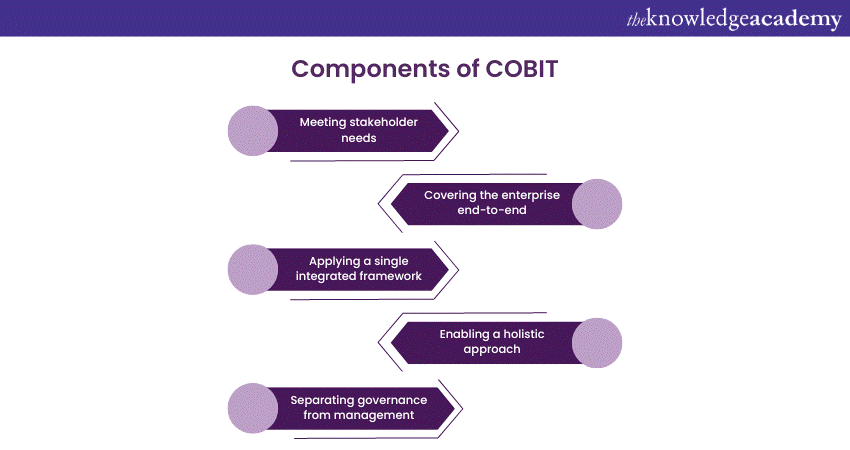We may not have the course you’re looking for. If you enquire or give us a call on +1800812339 and speak to our training experts, we may still be able to help with your training requirements.
We ensure quality, budget-alignment, and timely delivery by our expert instructors.

Imagine a roadmap that guides companies to success. Even though they have the same goal, they take different paths to get there. That’s COSO and COBIT. In effective organisation management, the COSO vs COBIT comparison takes centre stage.
According to Statista, the projected revenue of accounting, bookkeeping, and auditing activities tax consultancy in the United Kingdom will amount to 37.6 billion GBP by 2025. COSO and COBIT play a crucial role in managing financial reports. Explore this blog on COSO vs COBIT and learn the Key differences between COSO and COBIT to enhance risk management and operational efficiency.
Table of Contents
1) What is COSO
a) Components of COSO
b) Benefits of COSO
2) What is COBIT
a) Components of COBIT
b) Benefits of COBIT
3) COSO vs COBIT Comparison
a) Focus and scope
b) Framework components
c) Applicability
d) Industry standards
e) Risk management
f) Maturity models
4) Choosing Between COSO and COBIT
5) Conclusion
What is COSO

The Committee of Sponsoring Organisations (COSO) is a vital framework that guides organisations in achieving effective governance, risk management, and internal control. Initially developed to address financial reporting concerns, COSO has evolved to encompass broader organisational control and risk management aspects.
Empower your IT governance journey with COBIT® Foundation - Unlock the power of effective IT management and alignment today!
Components of COSO
COSO is structured around five components:
a) Control environment: This sets the tone for control consciousness and establishes the organisational structure that promotes accountability.
b) Risk assessment: Organisations identify and evaluate risks that could impact their objectives, enabling better decision-making.
c) Control activities: Specific policies and procedures are designed and implemented to address identified risks and achieve organisational goals.
d) Information and communication: Important Information is recognised, gathered, and shared throughout the organisation to aid in making decisions.
e) Monitoring activities: Ongoing evaluations ensure that controls remain effective, weaknesses are addressed, and improvements are made.
Benefits of COSO
COSO offers several advantages:
a) Enhanced internal control: It systematically creates and maintains internal control systems that optimise operations and asset protection.
b) Improved risk management: COSO aids in identifying, assessing, and mitigating risks, leading to informed risk-taking.
c) Better compliance: Regulatory and compliance requirements are better met, reducing legal risks.
d) Increased transparency: The framework promotes transparent reporting, fostering stakeholder trust.
Dive deep into Cobit Interview Questions and Answers and get ready to impress your interviewer!
What is COBIT
Control Objectives for Information and Related Technologies (COBIT) is a significant Information Technology (IT) governance and management framework. It provides guidelines that help organisations align their IT strategies with business goals while effectively managing risks associated with technology.
Components of COBIT

COBIT is built on five essential principles:
a) Meeting stakeholder needs: COBIT emphasises the importance of aligning IT activities with the requirements and expectations of stakeholders.
b) Covering the enterprise end-to-end: It promotes a comprehensive approach that considers all IT-related processes and activities.
c) Applying a single integrated framework: COBIT encourages using a unified IT governance and management framework.
d) Enabling a holistic approach: This principle underscores the necessity of considering various aspects, such as processes, resources, and risks, holistically.
e) Separating governance from management: COBIT delineates the roles of governance and management in IT.
Benefits of COBIT
Here are Benefits of COBIT:
a) Enhanced IT governance: It provides a structured framework for aligning IT strategies with organisational goals, enhancing decision-making.
b) Improved risk management: COBIT assists in identifying, assessing, and managing IT-related risks effectively.
c) Optimised resource utilisation: Organisations can better allocate and utilise IT resources to achieve business objectives.
d) Standardised IT processes: COBIT promotes uniform processes and practices across the organisation's IT landscape.
Elevate your IT governance expertise with our comprehensive COBIT® Training – unlock the power of efficient IT management. Join now!
COSO vs COBIT Comparison
COSO covers broad control and risk areas, while COBIT focuses on IT. COSO fits various sectors, and COBIT is for tech-reliant organisations. Here is a comparison between COSO and COBIT:
Focus and scope
Established in 1992, COSO casts a wide net, focusing on internal control, enterprise risk management, and fraud prevention. It provides a comprehensive framework applicable across industries. On the other hand, introduced in 1996, COBIT takes a more specialised route, zeroing in on IT governance, risk management, and aligning IT processes with business objectives. It is particularly relevant for organisations heavily reliant on IT.
Framework components
The COSO framework comprises five interrelated components:
a) Control environment
b) Risk assessment
c) Control activities
d) Information and communication
e) Monitoring activities
These components collectively foster a comprehensive approach to organisational governance and control.
COBIT is structured around five key principles:
a) Meeting stakeholder needs
b) Covering the enterprise end-to-end
c) Applying a single integrated framework
d) Enabling a comprehensive approach
e)Separating governance from management
These principles guide organisations in optimising IT governance and management practice.
Applicability
The COSO framework transcends industry boundaries, finding relevance across diverse sectors beyond the IT domain. Its principles can be adapted to suit various organisational contexts. In contrast, COBIT is particularly suited for organisations heavily reliant on IT services. It provides comprehensive guidance for managing technology-related risks and aligning IT with business objectives.
Industry standards
COSO's expansive internal control and risk management perspective aligns with various industry standards and regulations. It provides a broader foundation for organisations seeking to enhance their control mechanisms. On the other hand, COBIT's integration with other IT-related standards and frameworks, such as ITIL and ISO 27001, makes it a valuable tool for organisations aiming to optimise IT processes and ensure compliance within the IT domain.
Risk management
COSO integrates risk management into its components, focusing on identifying, assessing, and responding to risks that could impact organisational objectives across various domains. Within the COBIT Framework PDF, risk management is seamlessly woven into IT governance processes. This approach ensures that IT-related risks are effectively identified and managed to safeguard technology-driven operations.
Maturity models
COSO offers guidance for assessing the maturity of internal controls, aiding organisations in evaluating and enhancing their overall control mechanisms. On the other hand, COBIT incorporates maturity models to assess the maturity of IT processes, providing a structured pathway for organisations to optimise their IT governance practices.
Choosing Between COSO and COBIT
Selecting between COSO and COBIT depends on your organisation's priorities and context. Here is a deeper look:
a) COSO: Choose COSO if you aim to enhance overall governance, risk management, and control mechanisms. It is a versatile framework applicable across industries beyond just IT. If your organisation seeks a comprehensive approach to managing risks, promoting transparency, and strengthening internal controls.
b) COBIT: Choose COBIT if your focus is on managing IT governance, aligning IT processes with business objectives, and effectively handling technology-related risks. COBIT's strength lies in its specialisation in IT domains. If your organisation heavily relies on technology for operations and you need a systematic way to optimise IT resources and manage IT risks, COBIT can guide your path.
Conclusion
Regarding steering organisational success, the COSO vs COBIT comparison provides crucial insights. COSO covers various aspects, while COBIT specialises in technology. Your choice depends on your organisation's goals. Both paths have strengths, so choose wisely to align with your best interests. In the end, the right decision ensures effective governance, risk management, and achievement of your objectives.
Upcoming IT Service Management Resources Batches & Dates
Date
 COBIT® Foundation
COBIT® Foundation
Thu 27th Mar 2025
Thu 24th Jul 2025
Thu 4th Sep 2025
Thu 6th Nov 2025






 Top Rated Course
Top Rated Course



 If you wish to make any changes to your course, please
If you wish to make any changes to your course, please


